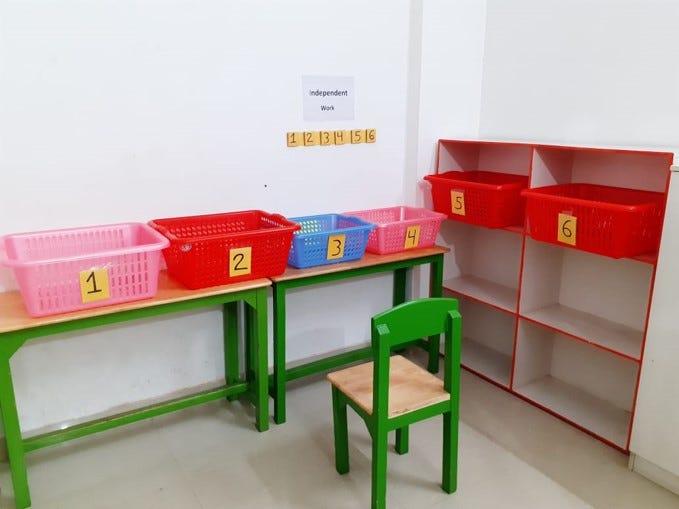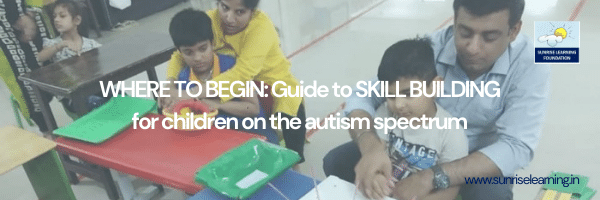Ms Devika Chugh, Counselor & Special Educator at SUNRISE LEARNING
Blog compiled by MS ANVI MAHAJAN
Starting with SKILL TRAINING when the children are still young is a great idea!
Developing skills that enable children on the spectrum to move towards independence is an important milestone in a parent’s journey. Here are some methods you can employ to begin and sustain skill training in your child!
We’ll be talking about:
1. Structure: How can visual and physical structures help?
2. Work system: How can you maximise efficiency?
3. Consistency and regularity: The golden key to progress!
Compensating for executive functioning:
Often, people on the spectrum face challenges with attention, concentration, impulse control, and waiting. They may have challenges with working memory, planning and organizing skills, multitasking and self-monitoring skills. These skills together come under the umbrella of executive functioning.
Children on the spectrum have deficits in executive functioning, hence, we must attempt to externally strengthen these functions as neuroscience has not advanced enough to modify neurological connections and wiring. The good news is that studies have shown that in an enriched environment, there is enormous scope for neuro-adaptability. Consistently applying well-established techniques in an enriched environment with proper environmental stimulation can show promising results.
This enriched environment can be achieved by:
- Modifying the physical environment
- Modifying the task- If the task is too big or complex and the child faces issues in planning or organizing, we can divide the task into smaller parts or add visual cues and indicators.
- Individual coping strategies- These cater to the child’s specific needs. For example- creating to-do lists, letting the child chew gum to remain focused.
- The larger goal to strive towards is that as the child grows older, they can create their checklists and schedules and can work according to them. Your role is to provide a consistent habitual routine to develop this thinking process. For example- if a child tends to blurt out and speak without permission while a teacher is talking, they can be taught to raise their hand to ask for permission before speaking. This can be done by placing visual cues and reminders on the table.
STRUCTURE
It is a clear-cut system or framework with a clear flow that helps organize the environment, time and activities to ease functioning while maximizing productivity, independence and motivation.
Strategies to structure:
- Physical structures– Providing well-defined physical boundaries and areas. The areas should be demarcated and indicative of the activity that is to be performed there. For example- In the study area, a table, chair and distraction-free environment will tell the child that he/she is supposed to study here.


2. Structure of Activities: Often parents struggle with keeping the child engaged in the activity. For this, we must structure for success. If the child’s capacity is 10 minutes, you may begin by performing the task for 7 minutes and gradually increasing the duration. We must reinforce and reward children when they follow the cues and the set routine. The physical area should be structured to ensure it is distraction-free and devoid of a sensorily overloaded environment (too many noises or lights etc.)


3. Structure of Time: Visual schedules– Provide a sequence of activities indicating when and where a child should be and what task is to be done at a given time. Often, instructions are lost in translation or they may not be registered due to lack of sustained attention. Verbal language is fleeting and can change rapidly. In these cases, visuals are much more effective as they don’t change, are concrete and remain imbued in our memory for longer.


Independence and flexibility– Once the child has learnt to follow the schedule and routine regularly and properly, you can play around with the schedule to introduce some flexibility by adding a new task or activity into the set routine.
Schedules should be prepared to keep in mind the child’s needs. The length of the schedule should be optimal and not too overwhelming. The schedule should be able to make accommodations to ensure it is acceptable on the child’s worst day as well, when he/she may be having critical meltdowns. The schedule should be placed in a neutral and accessible location and you must teach the child how to check the schedule (ideally, the child goes to the schedule). The schedule should be portable so that it can be carried along easily, giving more independence when they make their own schedules and follow them.
Forms of representation– you can use concrete objects, images, illustrations or written content to make these schedules, depending on the child’s comfort. A schedule should be easy and meaningful, easy to associate with the corresponding tasks and acceptable to the child on even their worst day.
WORK SYSTEM


A work system helps the child understand what is expected out of the student and what is to be done after the task is over. An activity structure or mini schedule must include the following-
- The activities or steps the student is supposed to do. for example- sorting or matching colours
- The number of activities or steps to be done. For example, matching 10 colours
- Well defined start and finish points and indicators.
- What to do after the activity is completed. This includes some form of reinforcement or reward. The goal is to start with reinforcement and then move to verbal cues (saying ‘’Finish’’ to mark the end of a task) and ultimately to a stage of intrinsic motivation where the child becomes habitual of completing tasks.
- Change the tasks at a reasonable time.
- Only relevant items should be present, with no clutter.
- Left to right arrangement. This can be understood with the following images-

Visual Structure
Visually showing how an activity is to be done. For example- placing a picture of what should be the finished structure while playing with building blocks.
· Visual instructions– visual markers to show where to begin and finish an activity.
· Visual organization– used to indicate where the materials are 9laying out the materials)
· Visual clarity– Laying out each step of the activity in detail so that it can be followed along easily
You can use baskets, folders or trays to organize the workstation better. It is also helpful to filter out and emphasize important information. This can be done by highlighting, colour coding or numbering the instructions.
Remember, it is crucial to supplement the verbal instructions with visual cues and reminders.
Why does structure matter?
- Creating a well-designed structure can do wonders.
- Provides clarity in terms of work, time and space.
- Provides clarity of what, where, when and how.
- Provides predictability and certainty.
- It eases out the anxiety felt during change or transitions from one activity to another.
- Provides the big picture.
- Helps those who find it difficult to follow verbal instructions.
- Helps those who have trouble accepting authority as they can see and follow instructions for the task.
Structure and visuals for independence
The prefrontal cortex of our brain helps sustain attention and remain focused on a task. It helps monitor our actions and shift and adapt according to our needs or circumstances. People on the spectrum suffer deficits in these functions. We aim to compensate for these with external structures and visuals. As the child grows older, we expect him/her to internalize these functions and perform these tasks on their own.

Apart from all this you can also plan playtime to boost there skill further. Read our article on PLAYTIME IS POWERFUL.HOW CAN PLAY HELP AUTISTIC CHILDREN
If you have any queries, do not hesitate to write us at contactus@sunriselearning.in
[mc4wp_form id=”4687″]

